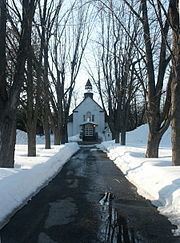Country Canada Time zone EST (UTC−5) Area code(s) 450 and 579 Area 12.2 km² Population 14,294 (2011) Local time Wednesday 5:58 PM | Constituted January 1, 1947 Postal code(s) J6Z to J7H Highways
A-640 Route 117
Route 344 Elevation 29 m Province Québec | |
 | ||
Weather -7°C, Wind W at 19 km/h, 35% Humidity RCMs Laurentides, Thérèse-De Blainville Regional County Municipality | ||
Rosemère is an affluent off-island suburb of Montreal, in southwestern Quebec, Canada on the north shore of the Rivière des Mille-Îles in the Thérèse-De Blainville Regional County Municipality. The town is noted for its green look, due to the high density of trees. Some wooded areas in the town have been left intact as the town has grown around them. Homes are mostly upscale, varying from renovated cottages to unique character homes. It is almost entirely residential, with no significant industries. Boulevard Curé-Labelle, the town's main commercial artery, is lined up by suburban shops and shopping malls, the largest of which is Place Rosemère.
Contents
Map of Rosem%C3%A8re, QC, Canada
Its most famous resident is likely Alexandre Bilodeau, who became the first Canadian athlete to win an Olympic gold medal on Canadian soil. He won the Men's Moguls event at the 2010 Winter Olympic Games in Vancouver, BC.
Demographics
According to the Town of Rosemère website:
History
The area that would become Rosemère was first settled in 1714, with the establishment of the Mille-Îles Seigneury. By 1780, the Seigneury was well established, with large tracts of land under cultivation. Rosemere was named by J.P. Withers, of the Canadian Pacific Railway, who moved to the area in 1880. At first he called his new home "Rose", after the many wild roses growing there. Later he added "mere" an old English word for a lake. The Mille-Îles river is wide and has the appearance of a lake at this location. So the English meaning would be "lake of roses". After the town's incorporation documents were forwarded to Quebec City, an accent was added to the middle e; according to statements by residents. In French, the name does not mean "Mother of Roses", which would be said "Mère des Roses" in French. The town's name has no sensible meaning in French, though in typical Canadian fashion, the name has become bilingual.
In the first half of the last century, Rosemère had several natural sandy beaches on the Rivière des Mille-Îles and many cottages along the shoreline that were only used during the summer. These beaches fell into disuse in the early 1960s because of pollution. A majority of the year-round residents were francophone and many of the summer-only residents were anglophone. After World War II, Rosemère was transformed into a bedroom community of Montreal with the construction of homes in farmland and forested areas NW of Grande Cote. By 1964, 65% of Rosemère's residents were anglophone. While the French and English residents of Rosemère have always enjoyed the ambience of the area in harmony, the English population has declined over the years to today's 16% (Statistics Canada 2001 Census), but has since climbed to 19.89% (Statistics Canada 2006 Census).
The French and English speaking communities of Rosemère have been cohabitating for a long time, each of them leaving its own mark and institutions. In 1992, a public consultation process confirmed the desire of residents to preserve the Town of Rosemère's bilingual status.
Education
The Commission scolaire de la Seigneurie-des-Mille-Iles (CSSMI) operates French-language schools in the city.
Furthermore, the administration building for the Sir Wilfrid Laurier School Board which operates English-language schools found in the Laval, Laurentian and Lanaudière regions is located in Rosemere. It neighbours one of its secondary schools, Rosemere High School which also houses the English school board's educational and complimentary services. The board also operates McCaig Elementary School, which is located in very close proximity to the high school, as it is located on the same street.
Transportation
Rosemère is connected to Montreal's Lucien-L'Allier Station by commuter rail via the Rosemère Station of Agence métropolitaine de transport's Saint-Jérôme Line. Local bus service is provided by CIT Laurentides.
